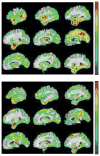DISEASE CLASSIFICATION AND PREDICTION VIA SEMI-SUPERVISED DIMENSIONALITY REDUCTION
- PMID: 28603581
- PMCID: PMC5466414
- DOI: 10.1109/ISBI.2011.5872590
DISEASE CLASSIFICATION AND PREDICTION VIA SEMI-SUPERVISED DIMENSIONALITY REDUCTION
Abstract
We present a new semi-supervised algorithm for dimensionality reduction which exploits information of unlabeled data in order to improve the accuracy of image-based disease classification based on medical images. We perform dimensionality reduction by adopting the formalism of constrained matrix decomposition of [1] to semi-supervised learning. In addition, we add a new regularization term to the objective function to better captur the affinity between labeled and unlabeled data. We apply our method to a data set consisting of medical scans of subjects classified as Normal Control (CN) and Alzheimer (AD). The unlabeled data are scans of subjects diagnosed with Mild Cognitive Impairment (MCI), which are at high risk to develop AD in the future. We measure the accuracy of our algorithm in classifying scans as AD and NC. In addition, we use the classifier to predict which subjects with MCI will converge to AD and compare those results to the diagnosis given at later follow ups. The experiments highlight that unlabeled data greatly improves the accuracy of our classifier.
Keywords: Alzheimer’s disease; Basis Learning; Matrix factorization; Mild Cognitive Impairment (MCI); Optimization; Semi-supervised Learning.
Figures


References
-
- Batmanghelich Nematollah, Taskar Ben, Davatzikos Christos. A general and unifying framework for feature construction, in image-based pattern classification. Inf Process Med Imaging. 2009;21:423–434. - PubMed
-
- Ashburner J, Friston KJ. Voxel-based morphometry–the methods. Neuroimage. 2000 Jun;11(6 Pt 1):805–821. - PubMed
-
- Carroll Melissa K, Cecchi Guillermo A, Rish Irina, Garg Rahul, Ravishankar Rao A. Prediction and interpretation of distributed neural activity with sparse models. Neuroimage. 2009 Jan;44(1):112–122. - PubMed
-
- Fan Yong, Shen Dinggang, Gur Ruben C, Gur Raquel E, Davatzikos Christos. Compare: classification of morphological patterns using adaptive regional elements. IEEE Trans Med Imaging. 2007 Jan;26(1):93–105. - PubMed
-
- Golland Polina, Eric W, Grimson L, Shenton Martha E, Kikinis Ron. Deformation analysis for shape based classification. In IPMI. 2001;2082:517–530.
Grants and funding
LinkOut - more resources
Full Text Sources
